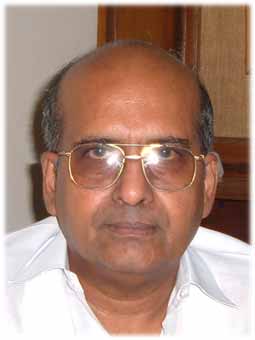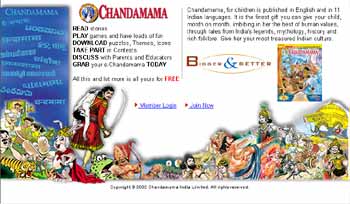“Unless it can have the benefit of support from a global player, Chandamama cannot on its own, think of producing programmes in animation medium.”

While Comics and illustrated children’s magazines may be big business internationally, India has had a few strong brands and players. In what is a global trend, popular characters from comics and story books are lending themselves very well to the medium of animation.
Do the Indian brands and comics have characters as strong that can be similarly adapted into animation?
Currently in its 58th year of publication, Chandamama, one of the earliest children’s magazines in the country is a veritable treasure house of stories. The publishing house became a corporate body in the late 90’s and did consider animation at that time. What were the experiences? What were the roadblocks?
While in Chennai, Animation ‘xpress’ Anand Gurnani met up with Chandamama India MD Vishwanathan Reddy.
Here are excerpts from the chat….
How long has Chandamama been enthralling readers, could you please enlist the statistics for the benefit of our readers?
Chandamama was launched in 1947, months before India got independence. The objective was to take India’s heritage and folk tradition closer to children who were standing on the threshold of freedom and who had till then been denied of much knowledge of the country’s hoary past and culture. The magazine first came out in Telugu and Tamil and because of their popularity, ten more language editions were added in as many years that followed. Sanskrit, which is generally taken as a dying language, is one of the languages in which an edition is being published in the last 21 years with a view to promoting that language among a large interested group. Recently, an enquiry came from far off Italy for the Sanskrit edition. For the first time an edition in a tribal language – Santali – is being published since September 2004. Thus currently, the magazine is coming out in 13 languages – hailed as a publishing feat anywhere in the world. A separate magazine for the below 9 years age group, Junior Chandamama in English, is soon to enter the third year of publication. The National Readership Survey IV put the readership as 9,400,000 adults besides the targeted audience of children between 5 and 18.
When did you first consider lending your content to the animation medium? What was your experience?
Till the nineties, our country was not ready for animation. Mr. Ram Mohan of Mumbai could create interest among some Japanese producers to consider producing the Ramayana as a full length animation feature. In the late 80s, the publishers of Chandamama were promoting Disney’s interests in India by publishing Disney comics. One of the group companies was involved in merchandising and franchising their products and characters. That gave me an opportunity to visit their studios and study the animation technique, but I found that the Indian market was not ready to go in for animation in a big way. TV itself was yet to become so common then.
When Chandamama became a corporate body in the late 90s, we started offering our archival content for syndication, besides going into multimedia to produce CD-Roms with the object of using story content for educational purposes – an edutainment endeavour – to reach out to children, entertaining and educating them.
We also thought of animation as a medium in collaboration with one of the leading international TV channels to power their children’s segment, both for their website as well as television. At that time, we had our own in house modest 3D and 2D facility to develop our own characters and story-board as part of the understanding we had with the said channel.
Unfortunately, we had to withdraw from the activity when the dotcom went bust and the said channel called off their arrangement with us. During that period, I happened to visit quite a few animation production units who were making a beginning to launch their programmes. It only proves that animation as part of the entertainment industry must aim at a global market while serving the local audience. Otherwise the expenditure and manpower it (animation) demands may not be a viable proposition for any production unit for the Indian market.
What roadblocks did you face in animation and why did the project not take off?
Some of the channels were over enthusiastic to join hands with Chandamama for the Asian market with Indian stories like folklore and mythology created by Chandamama, but when they sat down to study the time and the cost involved, they pushed all the projects into cold storage.
Unless it can have the benefit of support from a global player, Chandamama cannot on its own, despite the fact that it has access to beautiful subjects in its archives, think of producing programmes in animation medium.
What are your future plans as regards animation?
Today, Toonz in Trivandrum, Pendtamedia in Chennai, besides well-known units elsewhere in Mumbai and Hyderabad have been trying to come out with Indian themes. Unfortunately, I have not come across any final product comparable to programmes produced in Japan, the USA, or countries in Europe. Here again, I feel it is mainly due to financial and other constraints. Animation should be an institutionalised effort with the quality of overseas production in mind. I found most of the units were engaged in providing job work facility with most of the vital inputs provided by the producers from the USA or Europe.
Chandamama is always open to widen its horizon. Content-wise there is plenty that could be adapted for animation. Writing a story for the print media is different from creating a theme for multimedia or animation. Each one is unique as far as the treatment is considered. Yet we are confident of conveying the subject to suit different medium.

Do you think that the international model, (wherein famous characters lend themselves succesfully across formats and mediums) work well in India?
The popularity of characters, no doubt, take time to establish themselves as icons or idols. This is what happens in movies, where heroes and heroines easily become icons. Once the characters become popular, it is easy to go commercial, with the advantage of revenue generation through merchandising and franchisation means.
Today we find so many channels putting out animated programmes. However, it is only a handful of characters who appeal to children. After American characters fell out of popularity, we find a lot of Japanese characters gaining in popularity with the present generation. This is a universal phenomenon. India is just opening up in the global market. We are influenced by many things and we find children becoming addicted to cartoons on TV. After all, India is part of the global trend.
Additional comments…
It has come to a stage where we see 2D and 3D techniques being boldly integrated by the animation industry these days to make it more dynamic and realistic. This development may increase the cost of production further for any regional production unit to consider a full length animation film. Unless we are able to come somewhere closer to American or Japanese animation, quality-wise, Indian animation industry, I am afraid, can only become a service provider for producers abroad. We cannot be producers ourselves in our own capacity.
However, what I am able to gather from the trade journals is that many of the Indian animation units have inked contracts with overseas producers and tried to expand their manpower and capacities. I only wish that some of these units are also involved in creating software for Channels abroad and do their best to get India’s animation industry due recognition. We all know that India does not lack talent. It is my dream that India should set a new trend in presenting themes with positive messages, instead of just filling time-slots with violence and morbidity.

